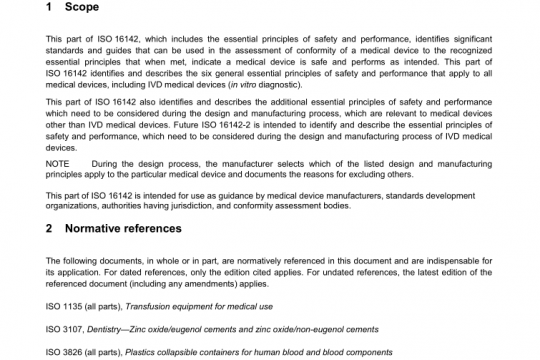AAMI VP20 pdf free download
AAMI VP20 pdf free download.Cardiovascular implants – Vascular graft prostheses.
3.7 component: Substance used during manufacture whether or not it is intended to remain as a consistent element of the device. 3.8 composite prosthesis: Vascular prosthesis in which the construction and/or material of construction varies in a segmental manner along the length (e.g., a prosthesis where the proximal portion is of crimped knitted fabric and the distal portion is of an aldehyde-treated animal vascular tube). (See also 3.9.) 3.9 compound prosthesis: Vascular prosthesis whose wall is uniformly constructed of materials from more than one source. (See also 3.8.) 3.10 configuration: Geometry of prosthesis (e.g., straight, bifurcate, tapered). 3.11 construction: Type of structure of a prosthesis (e.g., knitted, woven, non-woven, expanded polymer). 3.12 crimp: Creases or folds manufactured into a prosthesis to permit elongation and reduce kinking. 3.13 fibril: Strand of material which originates from one or more nodes and terminates at one or more nodes. 3.14 host: The recipient of an implant 3.15 implantable state: Condition of a prosthesis that has been prepared in accordance with the manufacturer’s instruction prior to implantation, or of a material of construction that has undergone the same process of sterilization and/or preparation. NOTE—Preparation does not include preclotting (see 3.20), but does include any recommended method of washing or soaking.3.16 integral water permeability: The volume of clean, filtered liquid (with a viscosity approximating that of water) which passes through the wall of a prosthesis in a specified time under a specified pressure. 3.17 leakage: The volume of clean, filtered liquid (with a viscosity approximating that of water) which passes through flaws in a water-impermeable vascular prosthesis in a specified time under a specified pressure. NOTE—Leakage may be either through small defects in the wall of a continuous tube or through an anastomosis constructed by the manufacturer. 3.18 node: The solid region within a material at which fibrils originate and converge. 3.19 porosity: Estimate or index of the ratio of the void within a material to the total volume occupied by the material including the voids. NOTE—Porosity may be expressed as the percentage void to the total area of volume, mean distance between nodes, or mean pore diameter. 3.20 preclotting: Procedure whereby blood or blood fractions are allowed to penetrate and coagulate within the interstices of a porous prosthesis to decrease the permeability. 3.21 primary component: Substance incorporated into the finished prothesis whose addition is designed by the manufacturer to improve the performance of the device. 3.22 prosthesis: (plural: prostheses, adjective: prosthetic). Any device which replaces or substitutes for an anatomical part or deficiency. 3.23 residual materials: Substances that are employed in the manufacture of the prosthesis, but are intended to be removed or are not required in the finished prosthesis. 3.24 secondary component: Substance that may be incorporated into the finished prosthesis, but is not primarily responsible for the stated function.3.25 substrate prosthesis: A vascular prosthesis to which a coating meeting the definition of is applied. 3.26 synthetic material: Substance of non-biological source that is produced and/or polymerized by chemical or physical means. NOTE—Chemically modified materials derived from fossil biological remains, e.g., petroleum or oil, are considered to be synthetic. 3.27 synthetic non-textile prosthesis: A vascular prosthesis manufactured using non-textile processes, e.g., extruded polymer, expanded polymer. 3.28 synthetic textile prosthesis: A vascular prosthesis made from yarns using textile fabrication methods, e.g., knitted, woven, braided. 3.29 usable length: Length of a prosthesis available for implantation, determined under a specified fixed load (which may be zero for certain prostheses). 3.30 vascular prosthesis (vascular graft—deprecated): Prosthesis used to replace, bypass, or form shunts between sections of the vascular system. 3.31 velour: Fabric with a cut or looped pile or with a napped surface.AAMI VP20 pdf download.
Other IEC Standards
-

ANSI AAMI ISO 16142-1 pdf free download – non-IVD medical devices and guidance on the selection of standards
AAMI standards list DOWNLOAD -

ANSI AAMI ISO 16142-2 pdf free download – General essential principles and additional specifc essential principles
AAMI standards list DOWNLOAD


